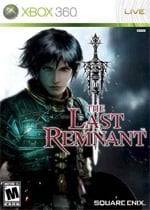Not Living up to Potential
This year has been pretty big for Square, with several Final Fantasy remakes coming to handhelds, as well as a few new spin-off titles. However, in spite of all the new Final Fantasy that fans have been able to digest, Square fans have also been treated to two completely new IPs this year, Infinite Undiscovery and The Last Remnant.
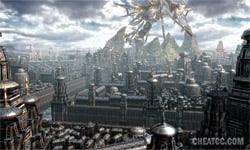
While the former took a very traditional approach to the genre, The Last Remnant aims to add a more epic tinge to regular turn-based combat, and, for the most part, this title succeeds at drawing you in to a new kind of RPG experience. However, there are quite few surprising issues that keep it from being the truly awesome RPG it could have been, and those who have been waiting on pins and needles for this title may find themselves a little disappointed.
The story in The Last Remnant starts simply enough and involves a young man named Rush Sykes, who is looking for his kidnapped sister. However, the story develops quite nicely into a sweeping political epic that involves “Remnants,” which are powerful relics that can be bound to unleash great power. These Remnants can also be unbound to cause chaos, and the struggle to contain these hidden Remnants’ power forms the backbone of The Last Remnant’s sweeping story. The story’s main strength lies in a compelling cast of secondary characters, including a mysterious villain known only as “The Conqueror.” The story in this title really is a major strength and a huge selling point.
However, if you are not into epic, sweeping storylines, The Last Remnant has an awesome battle system to help get your blood pumping. Instead of focusing on a small party system, The Last Remnant allows you to take on several union-style parties that can have up to 25 units each. Although you won’t have direct control over each character, you will be able to direct unit leaders and control the different types of attacks that each unit can perform (magical, physical, etc.) The main character, Rush, will be in charge of the action and has his own special abilities that are separate from the troop at-large. For Square-Enix aficionados, the game’s battle system functions much like that of Final Fantasy XII: Revenant Wings’ esper system with turn-based play replacing that title’s active elements and a stronger leader system
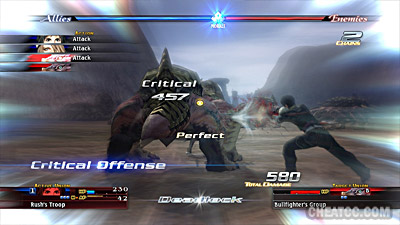
The battle system certainly is new and interesting, and despite players not being able to assign individual attacks to each character, there is quite a bit of strategy involved. Fighting with hundreds of allies and enemies at once gives this title a sense of grandiosity that is unmatched. In addition to managing unions on the battlefield, you can also tweak troop formation, which lends a bit of old-school strategy to this title. Unfortunately, there is not a lot of deep customization past this, and individual troop members will be responsible for their own stats and equipment. However, this is probably a necessary evil, as outfitting twenty or more warriors with equipment and leveling them up individually could take a lot of time.
Even though the battle system and story make this title stand out among other RPGs, there is a huge flaw in this title that is almost enough to ruin the entire experience: the graphics. Although the different environments and characters look great and have very detailed design, the game’s framerate is horribly inconsistent and often slows to a crawl during large battles. Because some of the game’s battles can have many characters onscreen, it seems that the game’s engine just can’t process all the different animations, and the action just stalls to compensate. Unfortunately, the framerate issues are not limited to just battle sequences, and when your character is running around different environments, there is quite a bit of shuddering, although the game rarely goes into “slide show” territory until battle sequences.
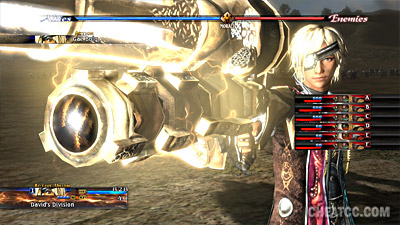
Although the framerate is the most egregious of this title’s graphical flaws and directly impacts the gameplay, there are several other major issues with the game’s overall look, including frequent pop-in texture issues. It is not uncommon for characters clothes to appear five or six seconds after you begin talking to them and then other details to appear several seconds after that. Although these pop-in issues are little more than an annoyance, they just compound the graphical issues in this title and indicate an overall lack of polish.
Persistent load times in this game also add to the frustration.Even though you can install both of the game’s discs to your hard drive, you will still experience 4-6 second load times every time you enter a room or engage an enemy in battle, which greatly hinders discovery quests, where you’ll have to frequently hop between cityscapes as well as enemy-infested locales.
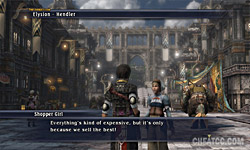
Sound in this title is somewhat of a mixed bag. The music is composed by Tsuyoshi Sekito, who is known for his work on the Final Fantasy series. The music is absolutely beautiful to listen to and has a rich and sweeping orchestral sound. The character voiceovers are hit or miss though and the main character sounds disinterested and ingenuous most of the time. However, several of the supporting characters do have decent voiceovers and manage to sound quite authentic.
Control is fairly standard, as far as RPGs are concerned, and features a fairly simplistic menu-based control scheme. There are a few instances where a timed-button press will be used to increase the effectiveness of a certain attack, but due to the aforementioned framerate issues, these are often easy to miss. But the bottom-line is if you have ever played an RPG before, you will be right at home with the control scheme.
For all intents and purposes, The Last Remnant has the makings of a great RPG: the story is engaging and the battle system is tons of fun to play with. And, with a lot of extra missions and side quests, there certainly is a lot of replay potential to this title. However, it seems that all these great aspects are not enough to pull it past its glaring graphical issues. If this title had been left in development just a little longer, then it might have been one of the best RPGs of the current generation. But as it stands, The Last Remnant is a great RPG that is buried under broken graphics and long load times.
RATING OUT OF 5 RATING DESCRIPTION 2.1 Graphics
Graphics are highly detailed and overall design is beautiful. However, persistent framerate problems and texturing issues ruin the look of this game. 3.4 Control
Command-based controls work very well, although quick-time prompts don’t work as well as they should because of technical issues. 3.7 Music / Sound FX / Voice Acting
The game’s score is beautifully orchestrated, but some of the voiceover dialogue sounds awkward. 3.9 Play Value
This title is quite lengthy, and the numerous side quests will keep you playing for quite awhile. 3.7 Overall Rating – Good
Not an average. See Rating legend above for a final score breakdown.
Game Features:
